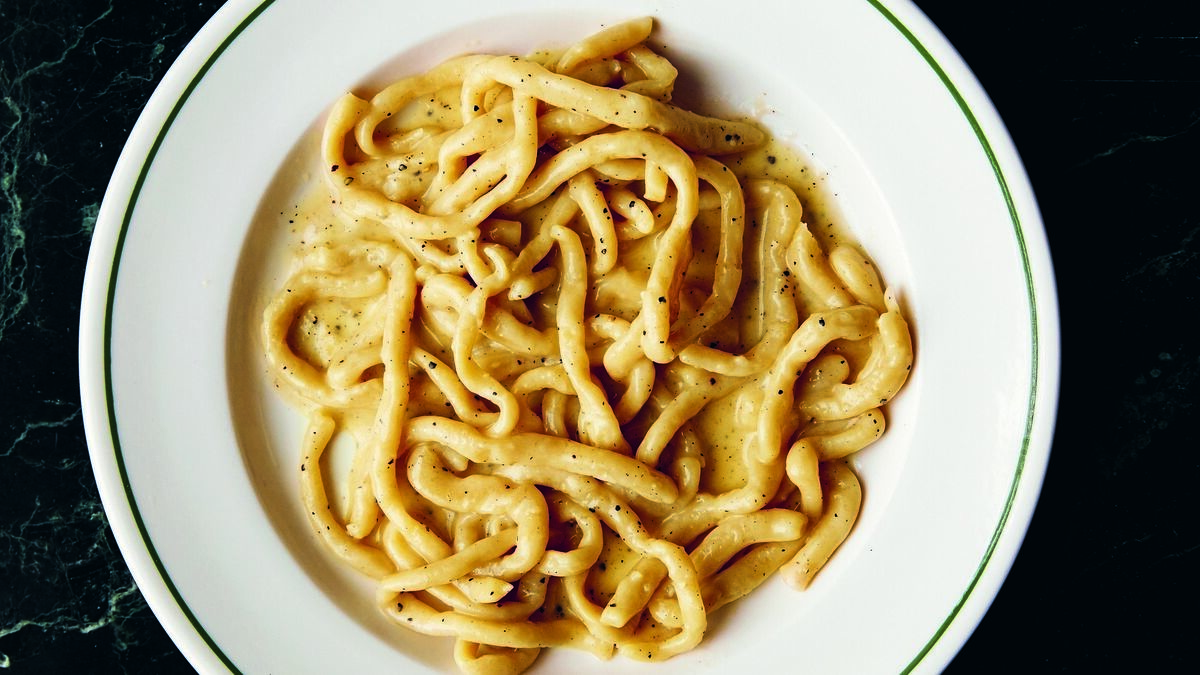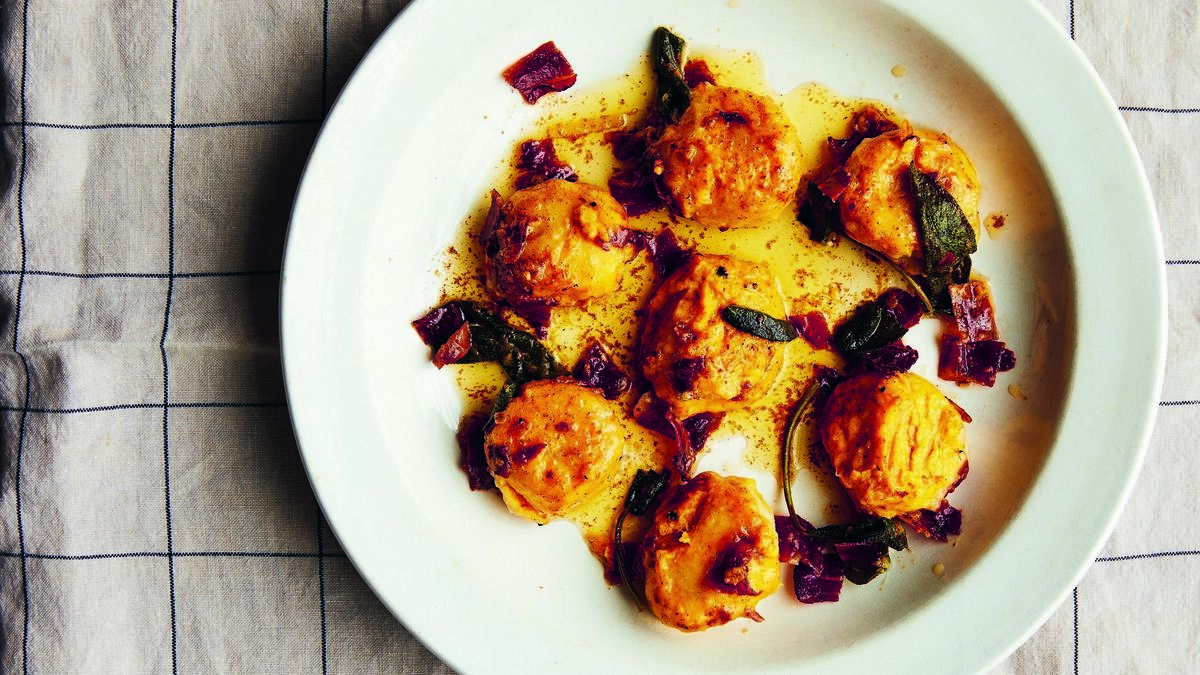Darina Allen: How to make three homemade pasta recipes, including cacio e pepe

Three Padella pasta dishes. Pictures: Sam Harris
Padella beside Borough Market in London is my absolute favourite London pasta restaurant. I love it so much that I’ve actually been pondering whether I really want to share this precious nugget of information. It’s already super busy and you can’t book, but it’s so good that I don’t mind waiting. It could be 30 to 60 minutes.
Padella’s Pici Cacio e Pepe
The key to creating the smooth, oozy sauce is grating the Parmesan super-fine

Servings
4Course
MainIngredients
500g fresh pici (see below)
About 1 heaped tsp freshly cracked black pepper
110g unsalted butter, cubed
a squeeze of lemon juice (about 10ml)
110g Parmesan, finely grated
Sea salt
For the pici dough
365g strong white bread flour, plus about 200g for storing the pici
155g tepid water
25ml extra virgin olive oil
5g salt
Method
For the pici, in a large cooking pot, bring 4-5 litres water to the boil and add a fistful of salt (only a fraction is absorbed into the pasta).
At the same time, in a pan large enough to easily hold all of the cooked ingredients, toast the freshly cracked pepper over a high heat for roughly 45-60 seconds or until you can smell the pepper, shaking the pan regularly to prevent it burning. Immediately add around 200ml of the seasoned pasta water (it will sizzle) and take the pan off the heat for 30 seconds.
Put the pan back over a medium-low heat, add the butter with the lemon juice to melt gently, then take off the heat. (It’s important to keep it off the heat while you cook the pasta, so that the pan isn’t scorching hot when you add the Parmesan.)
Loosen the pici bundles through your fingers so they won’t stick together as they cook. Drop the pici into the boiling water and cook for around 5 minutes.
Drain the pici as soon as it’s ready, keeping two mugs of pasta water.
Transfer the cooked pici to the buttery pepper sauce, put the pan back over a medium heat and stir until fully coated. Don’t worry if it looks quite soupy at this stage; the sauce will thicken more quickly than you think.
Add the grated Parmesan to the pici and stir vigorously to melt it into the sauce.
You should see a bit of steam rising out of the pan as you stir, so adjust your heat up if this isn’t happening. You might need to add small splashes of the reserved pasta water if the sauce needs loosening, stirring until you achieve a smooth, oozy sauce.
Once you’re happy with the consistency of the sauce, serve up the pasta on hot plates. Eat straight away.
To make the pici dough, put all the ingredients into a large bowl and mix until a dough is formed. (Alternatively, you can put all the ingredients into a food processor and whizz until a dough forms.)
Transfer the dough to a clean work surface and knead by pushing, stretching and rolling for few minutes until it’s smooth.
Wrap the dough ball in cling film and leave to rest somewhere cool for at least 30 minutes, or keep in the fridge for up to 2 days.
To roll the pici
1. On a clean work surface (ideally stainless steel, marble or unvarnished wood), cut off one-fifth of the dough and use a rolling pin to flatten it into a rectangle, about 3mm thick. (Keep the remaining dough ball covered with a damp tea-towel or wrapped in cling film.)
2, Using a knife, cut the flattened dough into 3-5mm strips.
3. Cut the strips of dough into roughly 10cm lengths.
4. Use the heels of your hands to roll each piece of dough into a thin pici strand, 20-30cm long and roughly 5mm diameter. (They should resemble grissini or thin breadsticks.)
5. Transfer the pici to a heavily floured tray or a large plate.
6. You can layer the pici on top of each other but make sure you heavily flour them as you layer, to prevent them sticking to each other.You can cook the pici straight away or store them in the fridge wrapped in cling film for 1-2 days.
Padella Fettuccine with ‘Nduja, Lemon and Mascarpone
In this recipe, the addition of mascarpone mellows the spiciness of the sausage and creates a smooth and creamy sauce, lending richness.

Servings
4Course
MainIngredients
450g fresh fettuccine (see recipe in Padella cookbook) *see note at end of recipe for alternatives
About 75g ’nduja
500g mascarpone
Finely grated zest and juice of 1 lemon
4 tbsp finely chopped flat-leaf parsley
Sea salt
Parmesan, finely grated, to finish
Method
Put the ’nduja into a bowl and bring to room temperature, so it becomes malleable. Add the mascarpone and lemon zest and mix together until well combined to form a smoothish paste. (This can be stored in a sealed container in the fridge for up to five days.)
For the pasta, in a large cooking pot, bring 4-5 litres water to the boil and add a fistful of salt. Put the ’nduja-mascarpone paste into a pan large enough to easily hold the cooked pasta. Add half a mug (about 120ml) of the seasoned pasta water and heat gently, stirring, to melt the paste and create a sauce. Take off the heat.
Loosen the pasta bundles so they won’t stick together as they cook. Drop the fettuccine into the boiling water and cook for about 1-1½ minutes. Drain the pasta as soon as it’s ready, keeping two mugs of pasta water. Transfer the pasta to the ’nduja sauce and add half a mug (about 120ml) of pasta water, the lemon juice, chopped parsley and a pinch of salt.
Stir vigorously for at least 30 seconds until all the ’nduja is mixed around the pasta and you have a smooth, creamy sauce. If the sauce is too dry, add splashes of the reserved pasta water to loosen it as you stir: you want it to be loose and for the strands of pasta to slide freely over each other, and for a layer of sauce to cover the bottom of the pan.
Taste and adjust the seasoning with salt and/or pepper if required.
Serve on hot plates with a creamy halo of sauce around the pasta. Finish with grated Parmesan.
Note: The sauce sucks up the Parmesan quickly and can easily become dry. So, be sure to have that excess halo around the plated pasta: my visual reference for the sauce is a slow-moving lava field.
Also works with: fresh pici; dried fettuccine, spaghetti, bucatini, linguine, penne, fusilli, farfalle.
Padella Ricotta and Pumpkin Gnudi with Crispy Pancetta, Sage and Parmesan
Gnudi are small balls of seasoned and flavoured ricotta that you roll in semolina flour and then poach. The creamy flavour goes really well with the sweet pumpkin and salty pancetta. Delicious...

Servings
4Course
MainIngredients
For the gnudi
1.5kg Delica pumpkin (or butternut squash), to yield 450g cooked pumpkin
¼ tsp freshly grated nutmeg
¼ tsp ground cinnamon
¼ tsp crushed dried chilli (or more if you like heat)
200g ricotta, strained of all liquid
1 medium egg yolk
50g Parmesan, finely grated, plus extra
To finish
25g plain flour 100g semolina, for shaping and coating
sea salt and freshly ground black pepper
For the sauce
about 20ml extra virgin olive oil
120g unsmoked pancetta, sliced paper-thin
120g unsalted butter, cubed
12 sage leaves
Method
Preheat your oven to 190°C/180°C Fan/Gas 5.
Cut the pumpkin into even-sized wedges, about 7-8cm, discarding the seeds. Place in a roasting tin and season with the nutmeg, cinnamon, chilli and salt and pepper. Roast in the oven for about 1 hour until the pumpkin is soft all the way through. Allow to steam-dry and cool (to drive off all excess moisture).
Scoop the pumpkin flesh out of the skin with a spoon, weigh 450g and place in a large bowl. Add the ricotta, egg yolk, Parmesan and flour. Mix well to form a smooth paste. Taste and adjust the seasoning with salt and/or pepper.
Put half the semolina into a bowl. Roll the pumpkin and ricotta paste into little balls, about 4cm in diameter, to create the gnudi. Drop the gnudi balls into the bowl of semolina and turn to coat all over. Scatter the rest of the semolina in a container, or on a tray or plate and sit the gnudi on top. Store in the fridge for 24 hours before using (this gives the gnudi a better texture).
Heat a thin layer (about 20ml) of extra virgin olive oil in a frying pan over a medium heat and fry the pancetta slices in batches until golden and crispy. Drain the pancetta on kitchen paper then chop into roughly 1cm pieces.
For the gnudi, in a large cooking pot, bring 4-5 litres water to the boil and add a fistful of salt. Turn down to a simmer.
Melt the butter in a saucepan large enough to easily hold the cooked gnudi. Add the sage leaves and fry over a low heat for 2-3 minutes until crispy and the butter has turned golden brown. Take off the heat and stir through the pancetta. Add small splashes of cold water and stir to stop the cooking.
At the same time, drop the gnudi into the pan of simmering water and cook for about 1½ minutes until they start floating to the surface. Using a large, slotted spoon, sieve or spider strainer, lift the gnudi out of the simmering water and add them to the pan with the sage and pancetta. Place over a low heat and gently fold the gnudi through the sauce for a few moments until they are nicely coated (be careful not to mash them!). If the sauce is a little dry, add small splashes of the hot cooking water to loosen it. Taste and adjust the seasoning with salt and/or pepper if required.
Serve on hot plates or bowls and finish with grated Parmesan.
- Recipes from Padella by Tim Siadatan (Bloomsbury Publishing, Hardback, £25). Photography © Sam A Harris
NOTS are delighted to partner with the Organic Growers of Ireland (OGI) to present their annual 1-day conference for horticultural growers and producers, and anyone interested in converting to organic growing.
Taking place in the Avalon House Hotel, Castlecomer, Co. Kilkenny on Tuesday, 25th November 2025, this event brings together organic growers from around Ireland for an in-depth day of presentation and discussions about the current issues and future plans.
Christmas is just around the corner so don’t delay….Get your order in for a beautiful free-range organic bronze turkey or a plump goose. Sounds like there may be a shortage of birds this year. Fewer and fewer farmers are rearing birds because of growing costs and fewer and fewer processing facilities open to artisans.
- Drinagh, Co. Wexford
087 668 2461, reganorganicfarm.ie
- Co. Carlow
(059) 911 7391, organicmeat.ie
– Co. Laois
086 389 2523 (Brendan), fiorbhiafarm.ie
- Co. Dublin.
(01) 2809120, cavistons.com






